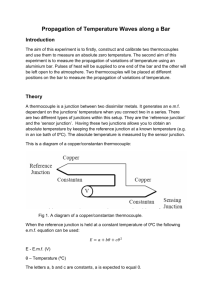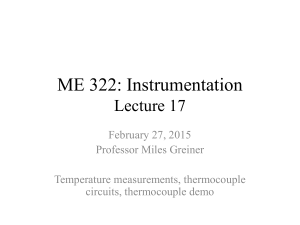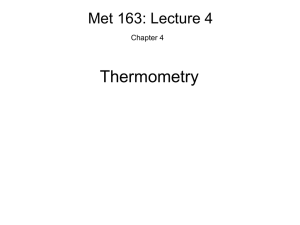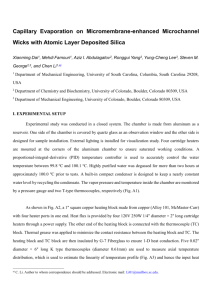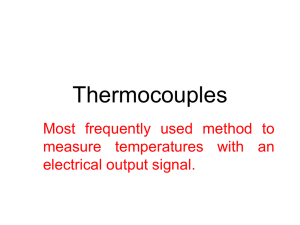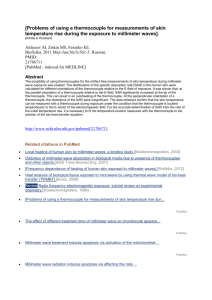Thermocouple Theory - Sensors & Controls
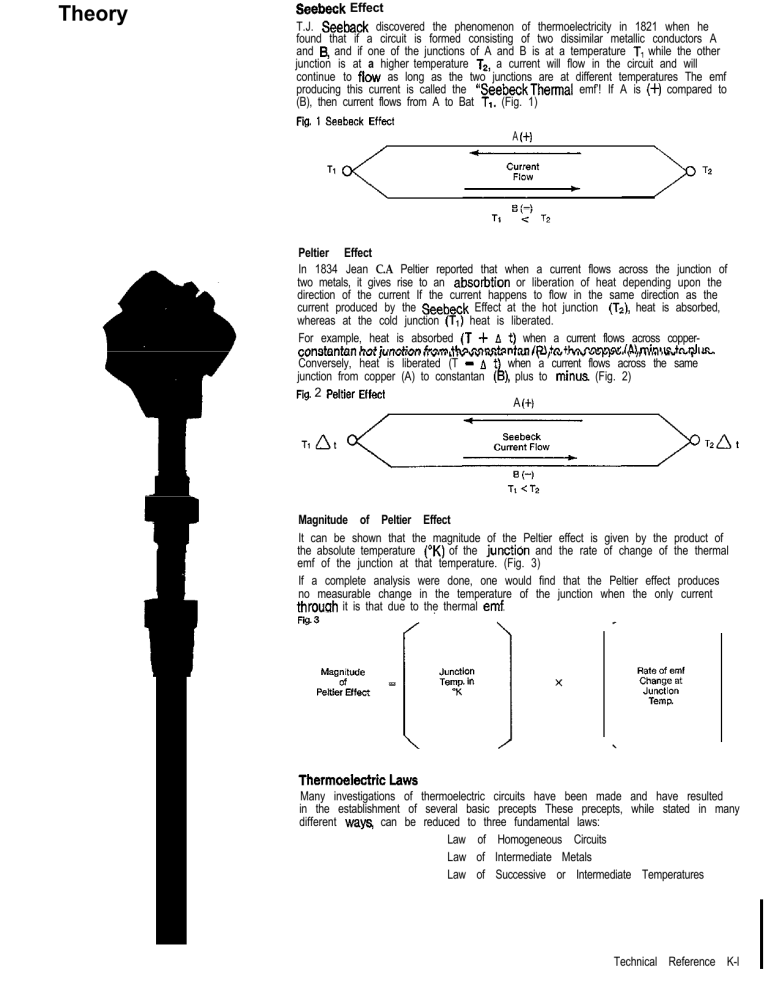
Theory
geebeck Effect
T.J. Seeback discovered the phenomenon of thermoelectricity in 1821 when he found that if a circuit is formed consisting of two dissimilar metallic conductors A and B, and if one of the junctions of A and B is at a temperature T, while the other junction is at a higher temperature Tz, a current will flow in the circuit and will continue to flow as long as the two junctions are at different temperatures The emf producing this current is called the ‘SeebeckThenal emf’! If A is (+) compared to
(B), then current flows from A to Bat T,. (Fig. 1)
Fig. 1 Seebeck Effect
A (+I
Peltier Effect
In 1834 Jean C.A Peltier reported that when a current flows across the junction of two metals, it gives rise to an absorbtion or liberation of heat depending upon the direction of the current If the current happens to flow in the same direction as the current produced by the Seebeck Effect at the hot junction (Tz), heat is absorbed, whereas at the cold junction (T,) heat is liberated.
For example, heat is absorbed (T + A t) when a current flows across copper-
““,,~,~,,,~,, ,l”.,“,,~..“,’ ,,“.,. .,.- ““...,..- . ..-.. \-, .” . ..” I”rr-. \. .,, ..t...-- .” r...-.
Conversely, heat is liberated (T - P t) when a current flows across the same junction from copper (A) to constantan (B), plus to minus (Fig. 2)
Fig. 2 .wtier Effect
A (+)
Magnitude of Peltier Effect
It can be shown that the magnitude of the Peltier effect is given by the product of the absolute temperature (“K) of the juncti6n and the rate of change of the thermal emf of the junction at that temperature. (Fig. 3)
If a complete analysis were done, one would find that the Peltier effect produces no measurable change in the temperature of the junction when the only current throuah it is that due to the thermal emf.
Many investigations of thermoelectric circuits have been made and have resulted in the establishment of several basic precepts These precepts, while stated in many different ways, can be reduced to three fundamental laws:
Law of Homogeneous Circuits
Law of Intermediate Metals
Law of Successive or Intermediate Temperatures
Technical Reference K-l
Law of Homogeneous Circuits
This law states than “an electric current cannot be sustained in a circuit of a single homogeneous metal, however varying in section, by the application of heat.alone”.
If a junction ot two dissimilar metals is maintained at T, while the other at Tz, the thermal emf developed is independent and unaffected by any temperature distribution along the wires (Ts and T4). (Fig. 4)
Fig. 4 Law 0‘ Homogeneous CirC”itS
A (+)
.
Theory
Law of Intermediate Metals
When thermocouples are used, it is usually necessary to introduce additional metals into the circuit This happens when an instrument is used to measure the emf, and when the junction is soldered of welded.
It would seem that the introduction of other metals would modiiy the emf developed by the thermocouple and destroy its calibration. However, the Law of Intermediate
Metals states that the introduction of a third metal into the circuit will have no effect upon the emf generated so long as the junctions of the third metal with the other two are at the same temperature.
If two dissimilar metals A and B with their junctions at T, and TZ and a third metal
C joined on one leg, if C is kept at a uniform temperature along its entire length, the total emf in the circuit will be unaffected. (Fig.,5)
F i g . 5 Law of intermediate Metals
A (+I
Law of Intermediate Temperatures
In most industrial installations, it is not practical to maintain the referenCe junction of a thermocouple at a~constant temperature. So, some means must be provided to bring the emf developed at the reference junction to a value equal to that which would be generated with a reference junction maintained at a standard temperature, usually 32°F.
The Law of Intermediate Temperature provides a means for relating the emf generated by a thermocouple under ordinary conditions to a standardized constant temperature. In effect, the law states that the sum of the emf’s generated by two thermocouples, one with its junction at 32°F and some reference temperature and thk other with its junction at the same reference temperature and the measured temperature - is equivalent to that emf produced by a single thermocouple with its junction at 32°F and the measured temperature. (Fig. 6) h wnf= Es = B +a2
I em‘% are Additive ‘or Temperature
K-2 Technical Reference
Intewa,s
T3
Summary of the Three Laws
The three fundamental laws may be qnbined and stated as follows:
The algebraic sum of the thermoelectric emf’s generated in any given circuit containing any number of dissimilar homogeneous metals is a function only of the temperature of the junction. If all but one of the junctions in such a circuit are maintained at some reference temperature, the emf generated depends only on the temperature of that one junction and can be used as a measure of its temperature.
Construction
Thermocouple Body Construction
There are many types of thermocouples available on today’s market Each has its own particular advantages and disadvantages In many cases, thermocouples and their accessories are designed for a specific temperature measurement problem. In other case% thermocouples are manufactured with a wide variety of applications possible. It is not the intent to compare one type of thermccouple with another, or to compare the thermocouple of one manufacturer with that of another. No thermocouple will do everything. Thermocouples must be selected to meet the needs of a particular installation. It is hoped that the next few will act as a guide in the selection process
The three basic types of construction are:
1. Wire
2. Mineral Insulated
3. Thermowell
Wire Type Construction
The most basic thermocouple construction is the wire type. It consists of two dissimilar metals, homogeneously joined at one end to form the measuring junction.
,,--......-.. .--. “. . ..-.-......-.. . . . . . .,r ---..-..--..-.. _._ . ..” .--....-. . .._. -....-.an exposed junction. The exposed junction, although it offers good response time is subject to environmental restriction?.
In most cases the advantages are good response time, ruggedness and high temperature use. On the other hand the disadvantage is the exposed junction which means that it is susceptible to the environment (oxidizing and reducing atmospheres), and therefore it must be protected.
Mineral Insulated Type
In order to overcome the disadvantages of the wire type construction, manufacturers developed the mineral insulated thermocouple.
The mineral insulated construction consists of two thermocouple material wires embedded in ceramic insulation and protected by a metallic sheath.
The two primary components of this construction are:
1. The mineral insulation material, and
2. The metallic sheath.
Sheath Material Characteristics
The illustration here (Fig. 7) shows just some of the many different materials which can be used to protect the mineral insulated thermocouple. The two most important parameters in selecting the sheath material are the operating temperature and the
~~~ospherir: envirQnment_ The atmospheric environmenta! oarameters are oxi+ing; reducing, neutral, and vacuum. For example, 304 Stainless Steel can be used m each type of atmosphere with a maximum operating temperature of 1650°F.
Mineral Insulation
Once again the illustration (Fig. 8) shows only a portion of those materials which are used, however, the five shown are the most common. The most important parameter to be considered in selecting the mineral insulations is the upper temperature limit and performance characteristics at that temperature. Of course there are other parameters which should also be considered such as resistivity, purity and crushability, however, they are secondary to temperature. For example, MgO, the most commonly used, as exhibited by this chart, has an upper temperature limit of
4350°F with high resistivity, excellent purity, and very good crushability.
Thermowells and Protecting Tubes
Thermowells and protecting tubes are used to shield thermocouple sensing elements against mechankzal damage and corrosive or contaminating atmospheres.
The various types and constructions which are available enable the user to select the right combination to meet individual needs
For example, cast iron protection tubes are used primarily in molten aluminum, magnesium, and zinc applications On the other hand, the ceramic tubes are used in other industries such as iron and steel, glas?, cement and lime processing. Their principal advantages include resistance to high temperatures and thermal shock, chemical inertness, good abrasion resistance and high dielectric strength.
I
K-4 Technical Reference
Measuring Junctions
Thermocouple
Cafi bration
The measuring or hot junction is the junction which is subjected to the process or medium which is being measured or controlled
The three common types of junctions are as follows:
1. Grounded
2. Insulated
3. Exposed
Of these three the one in greatest use is the grounded junction. As will be seen, its characteristics meet most requirements.
Grounded Junction
In this construction the mineral insulation is completely sealed from contaminents and the measuring junction becomesan integral part of the tip of the thermocouple.
The response time as we will see later approaches that of an exposed loop thermocouple, and in addition, the junction conductors are completely protected from harsh environmental conditions Small diameter thermocouples may be selected to match or better the response time of exposed loop thermocouples, yet the operational lift and upper temperature limit of the junction will be extended due to protection offered by the sheath material.
Insulated Measuring Junction
In this construction the thermocouple conductors are welded together to form the junction which is insulated from the external sheath with the mineral insulation. The response time for an insulated junction is longer than it is for a grounded junction thermocouple of the Same outside diameter. In insulated junction thermocouples, however, conductors are electrically insulated from the sheath; a feature advantageous in applications where thermocouples are used in conductive solutions, or when used isolation of the measuring circuitry is required.
Exposed Loop Junction
The exposed loop junction offers a faster thermal response time than the other two typesof junctions However, this type of junction is limited to mild environmental
Response Time
Some of the typical response time encountered when using these three types of junctions are as follows:
Insulated
Grounded
4.5 Seconds
1.7 Seconds
Exposed .OQ Seconds
(All vaues are for l/4 inch O.D. sheath)
As a general rule it can be stated that the greater the mass of the junction, the greater the response time, and the longer the service life.
The object of calibrating any thermocouple or wire is to determine temperature-emf output (voltage produced at a given temperature) as compared to the calibration table or curve.
The first method is the comparison method. This method is just what it impliesthe comparison oi the emi of an unknown thermocoupie with a worktng standard
(usually another thermocouple), at the same temperature. Accuracy is first limited by the accuracy of the standard A secondary effect limiting accuracy is the ability of the observer to bring the unknown thermocouple junction to the same temperature, as the standard’s measuring element l-k.3 mmnA rolikr.3*iAn mn+k,b-l ir tkn iivnrl nnir+ m.3+l,nrl Tkir rn.dkA.4
an+ri,c measuring unknown thermocouples at a known temperature as defined by the
International Temperature Scale.
Limits of Error for Standard and Premium GradeThermocouple Wire
No thermocouple can be more accurate than the wire from which it is made. Certain limits of error have been established by manufacturers and Engineering Societies to define acceptable wires for use in thermocouples.
The accuracy with which wire conforms to the tables is determined by checking the wire at predetermined points against NBS Certified Platinum. Checking against platinum insures that individual wires can be paired and remain within standard limits.
Technical Reference K-5
I
I
For instance, measurement at 300°F with a Type K thermocouple insures that the result will be 300 f 4°F for standard grade material and 300 f 2°F with premium grade material. Measurement at 1000°F with the same Type K insures thatthe result will be 1000 f 314% or 1000 f 75°F for standard grade material and 1000 + 3/8% or 1000 f 3.8-F for premium grade material.
Fixed Points Available for Selecting Thermocouples
The fixed points for which values have been assigned or determined accurately and at which it has been found convenient to calibrate thermocouples are given. In ca ““““1y “4 a “rrLll,y P”“‘I, I”1 rAollt)J,c;, L1IcJ ““lllll!g cl”llll “1 vnyya,, “I NW ,,acu,,y point of mercury. In determining the emf of a thermocouple at freezing point, the time during disertation which observations may be taken is limited to the period of freezing, after which the material must be melted again before taking further observations In the case of boiling points there is no such limit in time since the material can be boiled continuously.
This paper attempted to summarize the important aspects of thermocouple temperature sensors. It has primarily been aimed at the industrial user in order to help him understand more fully the basic principles of thermocouples The field of temperature measurement is so vast that each topic could have been a paper in IiSelf.
Briefly we have described the theoretical foundation of thenocouple thermometry aspect the basic construction of the thermocouple, two methods of calibration, and the critical parameters to be considered in the selection of practical sersora
Summary
K-6 Technical Reference
Upper and Lower
Temperature Limits of Thermocouples
Table I lists two sets of upper and lower temperature limits, continuous operation and table values. The upper and lower temperature limits for continuous operation are the maximum and minimum useful range of the thermocouple. This applies tc protected thermocouples, i.e., thermocouples made with bare thermocouple wire protected by ceramic tube or beads, under an oxidizing atmosphere.
The above upper temperature limits for continuous operation do not apply to metal sheathed thermocouples (CERAMO@). For example, the maximum limits for type K thermocouple is 2,300”F. However, 1 /16” diameter type K CERAMO can be used at 2,410”F in an inert (Argon) atmosphere. One should exercise extreme caution when using a thermocouple above the upper temperature limits recommended by ANSI.
The highest temperature to which a thermocouple can be exposed to (for one shot operation only) is dictated by the melting point of the thermoelement (eg, copper, iron or platinum) or the solidus temperature in case the thermoelement i!
an alloy (CHROMEL constantan or PVlORh). Under no circumstance should a thermocouple be heated to above the melting point orsolidus temperature of its thermoelements. The solidus temperature of an alloy is the temperature at which it begins to melt upon heating. The liquidus is the temperature at which melting i!
complete. Fig. 1 shows the phase diagram of a binary alloy system with complete solid solubility eg, constantan (44 NV55Cu). Fig. 2 illustrates the phase diagram c an alloy system with eutectic structure, eg ChromeI” (NV9Cr).
It should be noted the solidus temperature of an alloy in a phase diagram is under equilibrium condition. Many external factors can depress the solidus temperature as well as the melting point. For this reason, thermocouples should be operated at least 50°F lower than the listed melting point or solidus temperature of its thermoelements.
Type N (Nicrosil-vs-Nisil) have been shown to be more stable than type K thermocouples in an oxidizing atmosphere. The maximum temperature for continuous operation for both the type K and type N couples are 1,260X (2,3OO”F).
The maximum temperature listed in the table values for K couple is (1,372”C)
2,50O’F, while that for type N couple is only 1,300’C or 2,372”F. The reason: the solidus temperature for Alumel@ is believed to be 2,52o”F, while that for Nisi1 is
2,440”F.
The limits of table values refer to the highest and lowest temperatures at which standardized EMF values (ANSI or NBS) are available for the couple in question.
Therefore, theoretically, there is nothing to prevent anyone from making a temperature measurement with a thermocouple near its maximum upper temperature limit as listed in the EMF table for that thermocouple. Wecannot over-emphasize the importance of exercising extreme caution in this endeavor.
The lower limits for continuous operation in the cryogenic range has been set by
Therm0 Electric since none is set by ANSI. This is somewhat academic since the type T thermocouple (copper-vs-constantan) is essentially the only couple used for cryogenic temperature measurement from 0°C (32°F) to liquid nitrogen temperature, -196°C (-320°F). At liquid helium temperature, -269°C or +4”
Kelvin, a CHROMEL-gold thermocouple is the only couple which can be used for temperature measurement near absolute zero.
Table I Upper and Lower Temperature Limit of
ISA Letter Designated Thermocouples
Calibration
TlhI~Lower Limit
.““._
.,“......“_“”
Value Operation s”
B
J
T”
F.4
-210 (-346) -196 (-320)
-270 (-454) -196 (-320)
-270 (-454) -196 (-320)
-270 (-454) -196 (-320)
-270 (-454) -19; ;;;;O’
-50 (-58)
-“: E’
0 (32)
0 (32)
Temperature expressed in “C in (“F)
. ..“.V
Upper Limit
Value Operation
760 (1400) 760 (1400)
1372 (2502) 1260 (2300)
400 (752) 370 (550)
1000 (1632) 870 (1600)
1300 (2372) 1260 (2300)
1768 (3214) 1480 (2700)
1768 (32 14) 1480 (2700)
1820 (3308) 1700 (3100)
All information taken from ANSI MC96.1 (1982) except data on type N couples was taken from NBS 161 (1978).
Technical Reference K-
